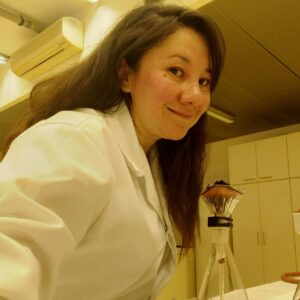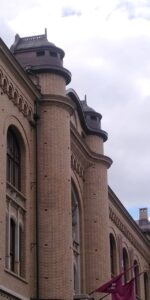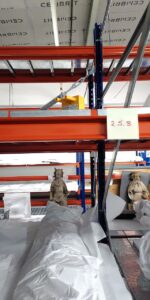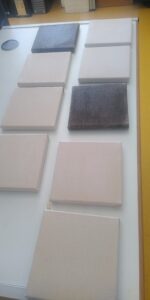About Paola Lucero-Gomez

For over a decade, Dr. Lucero has dedicated her career to unlocking the chemical secrets of cultural preservation. Since the beginning of her doctoral studies at Avignon University in 2009, she has become an expert in analyzing artistic and archaeological materials - from ancient resins and dyes to oil paintings and even pre-Columbian cacao artifacts.
Her research took a significant leap in 2018 when she joined Ca' Foscari University of Venice. There, she pioneered two groundbreaking approaches:
1. Developing innovative methods to monitor museum microclimates
2. Establishing connections between historical climate patterns and collection preservation.
Now at Palacký University Olomouc since 2021, Dr. Lucero's expertise was recognized with the prestigious Marie Curie Fellowship in 2023. This honor supports her current role as principal investigator of the SMARTMUS-e project, where she continues to bridge chemistry and conservation for smarter museum practices.
My relevant publications
A Comprehensive and Systematic Diagnostic Campaign for a New Acquisition of Contemporary Art—The Case of Natura Morta by Andreina Rosa (1924–2019) at the International Gallery of Modern Art Ca’ Pesaro, Venice
Piccolo, A, Bonato, E., Falchi, L., Lucero-Gómez, P., Barisoni, E., Piccolo, M., Balliana, E., Cimino, D., Izzo, F.C.
Heritage
Volume 4 (2021), 4372-4398
Abstract: In this work a campaign of diagnosis using mainly non destructive techniques: IRTF, Raman, photography with filters, hyperespectral imaging, FORS and GC-MS was undertake to analyze one iconoc work from the Ca’Pesaro collection in Venice. Hyperespectral and photographic techniques were able to detect an underdrawing, while GC-MS allowed the precise identification of the binder, IRTF and Raman allowed the characterization of the pigments.
Keywords: Andreina Rosa; heritage science; modern oil painting; conservation; oxalates; GC-MS; Hyperspectral Imaging Spectroscopy; FORS; ER-FTIR; degradation.
60 years of street art: a comparative study of the artists’ materials through spectroscopic and mass spectrometric approaches
Jacopo La Nasa*, Campanella, B., Sabatini, F., Rava, A., Shank, W., Lucero-Gomez, P., De Luca, D., Legnaioli, S., Palleschi, V., Colombini, M.P., Degano, I., Modugno, F.
Journal of Cultural Heritage
Volume 48 (2020), 129-140
Abstract: In this work several mural from contemporary artist were analysed, the molecular characterization was based mainly using Py/GC-MS analysis. This work traces back the evolution in the formulation of commercial paintings from the 50’s to our times with a detailed characterization of binders but also additives that can play a major role in the conservation or the degradation of an artwork.
Keywords: Mural painting, contemporary art, Py/GC-MS
An analytical strategy based on Fourier transform infrared spectroscopy, principal component analysis and linear discriminant analysis to suggest the botanical origin of resins from Bursera
Application to archaeological Aztec Samples
Pina-Torres, C., Lucero-Gómez*, P., Nieto, S., Vázquez, A., Bucio, L., Belio, I., Vega, R., Mathe, C., Vieillescazes, C.
Journal of Cultural Heritage
Volume 33 (2018), 48-59
Abstract: In this work I was for the first time corresponding author. This research presents the results from the analysis of triterpenic resins using IRTF and principal component analysis. This approach showed an ability of discrimination for the botanical origin of resins, similar to that of GC/MS analysis. The advantage of the IRTF/PCA approach is that is much faster and cheaper than the GC-MS approach.
Keywords: Mural painting, contemporary art, Py/GC-MS
Analysis of Mexican reference standards for Bursera spp. resins by Gas Chromatography–Mass Spectrometry and application to archaeological objects
Lucero-Gómez, P., Mathe, C., Vieillescazes*, C., Bucio, L., Belio-Reyes, I., Vega-Aviña, R.
Journal of Archaeological Science
Volume 41 (2014), 679-690
Abstract: This research present the results of an interdisciplinary research in the field of botany, chemistry and archaeology. Seven species of Bursera were selected, and resins from several threes of each specie were sampled in the forest. Then GC-MS characterization of the resins was performed, and molecular markers for each resin specie were identified. Finally, the molecular profile of archaeological samples was compared to that of modern materials, and a correlation to the botanical origin of archaeological samples was established.
Keywords: FTIR, botanical origin, secondary metabolites, natural resins, Bursera spp.
Archaeobotany: HPLC molecular triterpenic profiles for the discrimination of the botanical origin of copal in Mesoamerica. Application to the study of resins from objects from Aztec offerings
Lucero-Gómez, P., Bucio, L., Belio-Reyes, I., Vega-Aviña, R., Mathe, C., Vieillescazes, C.
Archéometrie Journal of GMPCA
Volume 36 (2014), 20-30
Abstract: In this work the resins from 7 species of bursera were analysed using liquid chromatography, These technique has been used very sporadically in the characterization of natural resins. This work show that a precise molecular profile could be distinguish according to the botanical origin of the sample. One drawback of this technique is that it is more expensive than GC-MS and requires a higher mass of sample for the analysis.
Keywords: Molecular profiles, GC-MS, Aztec offerings, natural resins.



